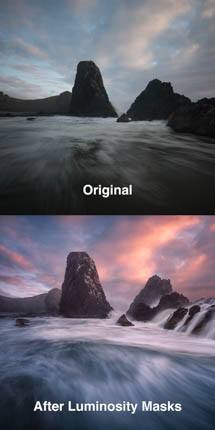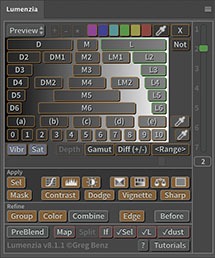Images of the ocean are some of my favorites, but often some of the most difficult to capture. The pounding waves, the corrosive salt, and continuous motion. Movement in the scene can create obvious problems when trying to blend multiple exposures. But it also creates other challenges. What’s the right shutter speed to capture waves? A fast shutter speed like 1/1000s will freeze every drop of water. A 5-minute exposure will render a silky white water that eliminates distracting details and reveals patterns in the surf. And there is a huge range of speeds in between that can be used to strike the right balance of motion and detail. I typically shoot between 1/5 and 2s, depending on the speed of the water and how much detail I wish to reveal. But even the perfect shutter speed is still missing something.
When we experience the ocean in person, it’s as if we are watching a movie. We see many waves over time. Each of them is different, and reveals something else about the scene. One might explode into the air as it crashes into a rock. Another may surge between a couple of sea stacks, revealing the depth between them. A single exposure, no matter how well shot, often cannot capture all that detail. So I like to blend multiple wave exposures into a single seascape image that captures the majestic nature of the ocean.
How do I use a tripod in the ocean?
Creating such an image typically requires shooting on a tripod, as you need images that are reasonably well aligned to blend (though as you’ll see in the tutorial video below, perfect alignment is often difficult to make, though not required). You’ll also likely be wading into the water, so personal safety is paramount, and you’ll need to use equipment that can withstand the elements. I shoot with a Really Right Stuff TVC-33 tripod. It’s extremely sturdy in the waves, and built to withstand corrosive salt and gritty sand. When setting up your tripod, try to press down as waves are coming in or going out, when the sand will soften and allow you to anchor the tripod deep. Once the tripod is a couple of inches into the sand, it should hold up very well against moderate waves. As an extra measure, I tend to keep my hands on the tripod for stability, catch it if it shakes loose, or be ready to move quickly if threatened by a rogue wave.
How do I blend waves in Photoshop?
Blending waves is relatively straight forward. The critical step is alignment. Even when shooting on a tripod, you are likely to have some movement or misalignment between your images. There are several reasons for this. Your tripod might not be fully anchored in the sand. The tripod can vibrate or shift as waves continue to hit it. Or you may be shooting in rocky conditions that won’t hold the tripod (in which case you may wish to hang some weight from your tripod for stability).
Normally, Photoshop does a great job of dealing with slight misalignment. But it needs a significant amount of static image content to work. If more than 50% of the image is in motion, automatic alignment is not going to work. Instead, you’ll need to manually align the images. Perfect alignment might need some rotation or even subtle resizing. But it typically isn’t necessary. You don’t need perfect alignment. You need only need alignment of the static parts of the image where you are blending two exposures. Just select the move tool and then use the arrow keys on your keyboard to shift the image one pixel at a time.
Of course, you also need to be able to visualize the alignment while using the move tool. There are several options. You can turn the top layer on and off, or set it to 50% opacity. I find that the best method is to temporarily set the top layer’s blend mode to “difference”. In difference mode, misaligned edges turn white, while a perfectly aligned image turns black.
Here’s an overview of the complete blending workflow:
- Put all the exposures into a single layered document in Photoshop. You can open multiple images in Photoshop and then click File/Scripts/Load Files into Stack (as I show in the video). Or, you can select multiple images in Lightroom, right-click and choose Edit in/Open as Layers in Photoshop.
- Move your main image to the bottom layer. And lock it to prevent making any accidental changes with the move tool or paintbrush later.
- Hide all layers but the bottom two (as you will be aligning one image at a time).
- Change the blend mode on the top visible layer to “difference”. This will show the alignment of the image.
- Make the top layer active and use the move tool (V) and arrow keys to align it with the bottom layer. You probably won’t get everything aligned, so focus on getting alignment in the areas where you plan to use from this layer for blending.
- If necessary, use the transform tool (<ctrl/cmd>-T) to further align the image. You can stretch the corners and rotate the image. This technique requires time and patience, and is probably not necessary if you shot on a tripod.
- Once the image is aligned, change the layer’s blend mode to normal or lighten (which will allow the bright water to show through, while hiding alignment issues in darker areas).
- Add a black mask to the top layer (<option/alt>-click the new layer mask icon). And lock transparency on the layer to avoid accidentally painting black and white on your image.
- Paint white onto the black mask to selectively reveal the layer. If you make any mistakes, just paint black to hide them again. A soft (hardness 0%) brush with high opacity (100%) and low flow (2-15%) is ideal for this sort of work, as it allows you to paint naturally and build up the blend with fewer brush strokes.
- Repeat steps 4-9 for each of the remaining layers.
Note: This article includes affiliate links. I only recommend equipment I use. For more information, please see my ethics statement.

